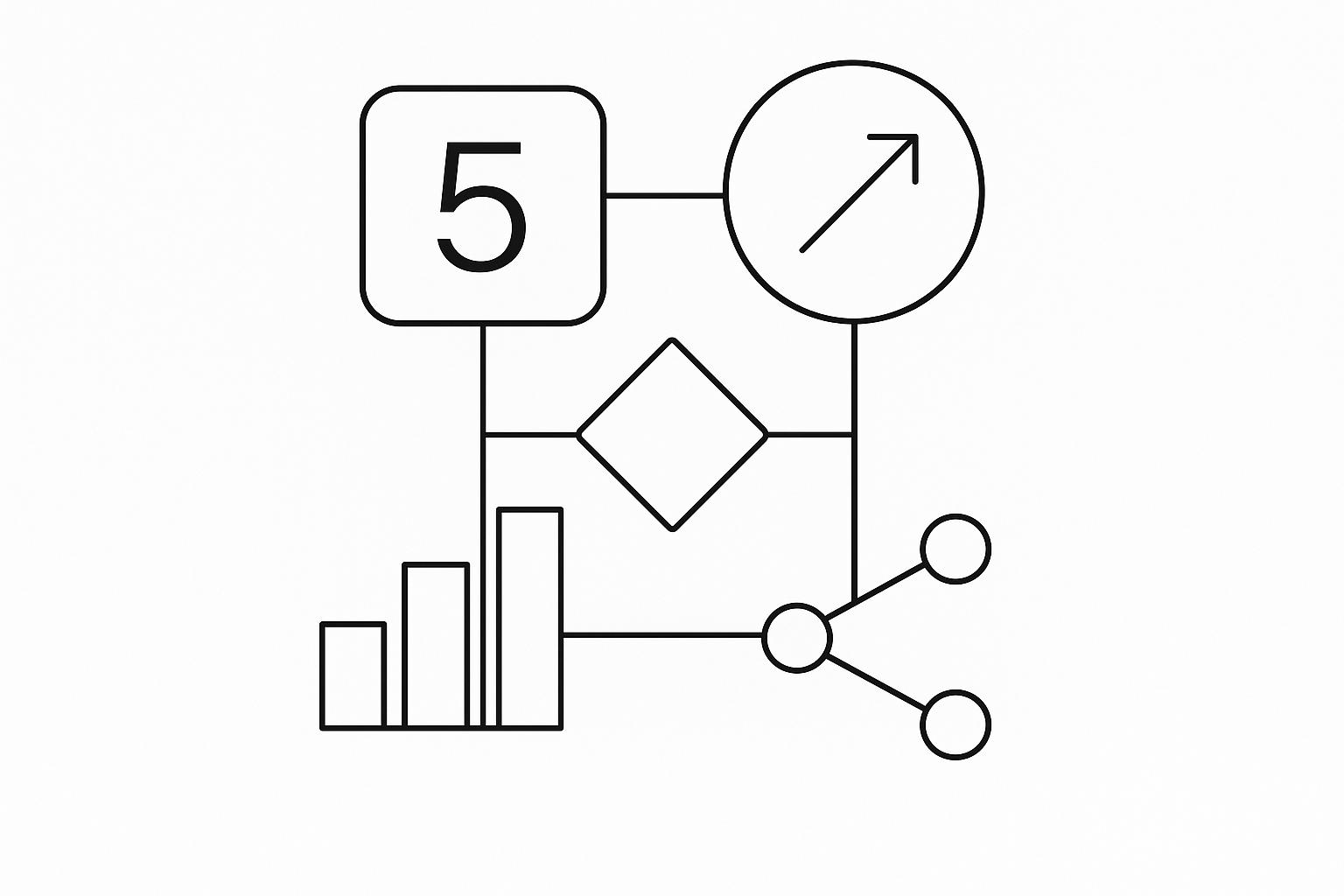Seasonal demand forecasting is critical for businesses to manage inventory, reduce costs, and meet customer needs during peak times. AI tools are transforming this process by analyzing large datasets, incorporating external factors like weather and social trends, and improving accuracy. Here’s what you need to know:
- Why AI? Traditional methods often fail to predict complex seasonal trends. AI reduces supply chain errors by 30–50%, lost sales by up to 65%, and operational costs by 5–40%.
- Top Tools
- Experiment Driven: Focuses on integrating marketing strategies with demand forecasting.
- Relex Solutions: Offers SKU-level, store-specific, and daily forecasts with 99% accuracy.
- ThroughPut AI: Provides sub-day insights and real-time adjustments for supply chain efficiency.
- LEAFIO AI: Pinpoints seasonal spikes early and optimizes inventory management.
- Retalon Retail AI: Enterprise-level tool with detailed seasonal trend analysis and inventory optimization.
Quick Comparison
| Tool | Focus | Forecasting Granularity | Key Features | Best For |
|---|---|---|---|---|
| Experiment Driven | Marketing + demand alignment | Customer-level, cohort-based | Real-time dashboards, CAC/LTV optimization | Marketing teams |
| Relex Solutions | Retail inventory management | SKU, store, daily | Advanced seasonality, markdown optimization | Large retailers |
| ThroughPut AI | Supply chain efficiency | Sub-day, SKU, store-level | Demand sensing, rapid adjustments | Supply chain-heavy businesses |
| LEAFIO AI | Seasonal inventory planning | SKU, store, location-based | Scenario analysis, new product predictions | Companies with diverse product portfolios |
| Retalon Retail AI | Enterprise retail operations | SKU, store, daily | Automated inventory allocation, ERP integration | Enterprise retailers |
AI tools are no longer optional - they are essential for staying competitive. Start with a pilot program to see how these tools can improve your forecasting and operations.
Seasonal Inventory Management Made Easy: Discover the Power of AI-Driven Demand Forecasting
1. Experiment Driven
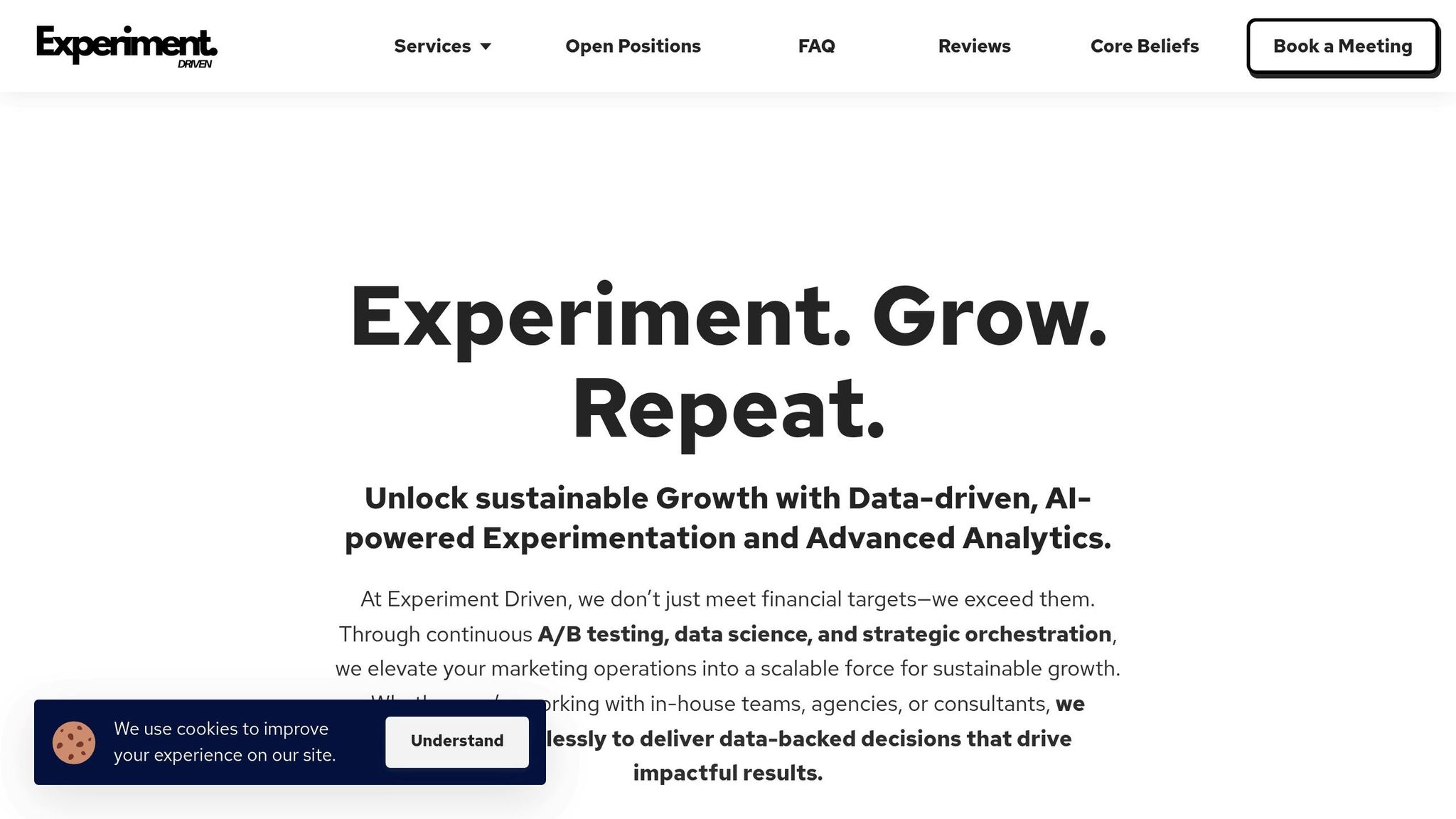
Experiment Driven is an AI-powered marketing platform designed to deliver data-driven seasonal insights by combining continuous experimentation with advanced analytics. Unlike traditional forecasting tools that mainly focus on inventory predictions, this platform goes a step further. It integrates seasonal demand patterns directly into marketing strategy optimization, creating a seamless connection between demand forecasting and marketing objectives.
By analyzing historical sales data across multiple seasons, Experiment Driven's AI algorithms uncover patterns that influence both demand fluctuations and marketing performance. This dual focus helps marketers predict not just when seasonal spikes will happen, but also how campaigns should adapt to make the most of these trends.
Integration with Marketing and Inventory Systems
One of the platform's standout features is its ability to merge marketing performance data with demand forecasting. Experiment Driven connects seamlessly with existing inventory management systems while keeping tabs on essential marketing metrics like Customer Acquisition Cost (CAC), Lifetime Value (LTV), and Cost Per New Customer during different seasonal periods.
The platform is equipped to handle large datasets for AI training and automates inventory replenishment based on real-time forecasts. Additionally, it continuously monitors model performance to ensure the accuracy and reliability of its predictions over time.
Experiment Driven also supports scalable data governance and pilot programs, making it easier for businesses to expand their use of the platform as needed. This integration ensures real-time data can be leveraged effectively across multiple channels.
Real-time Analytics and Dashboards
Experiment Driven takes its integration capabilities further with real-time performance dashboards. These dashboards provide instant insights into how seasonal trends impact both demand and marketing effectiveness. For example, marketers can track Cohort Payback Periods by Marketing Channels to determine which channels perform best during specific seasonal peaks.
The platform pulls real-time data from sources like point-of-sale systems, online transactions, and social media to identify emerging seasonal patterns. This is especially useful during unpredictable seasonal shifts, where traditional methods often fall short.
Customization for Seasonal Trends
The platform's AI algorithms are highly adept at identifying and adjusting to seasonal variations, including holidays, promotions, and broader seasonality. But it doesn’t stop there. Experiment Driven also factors in external influences like social trends and customer feedback, ensuring its forecasts are as comprehensive as possible.
This approach has delivered measurable results across industries. With probabilistic forecasting, businesses have seen forecast accuracy improve by 15-25%, while errors and lost sales have been reduced by more than 30%.
2. Relex Solutions
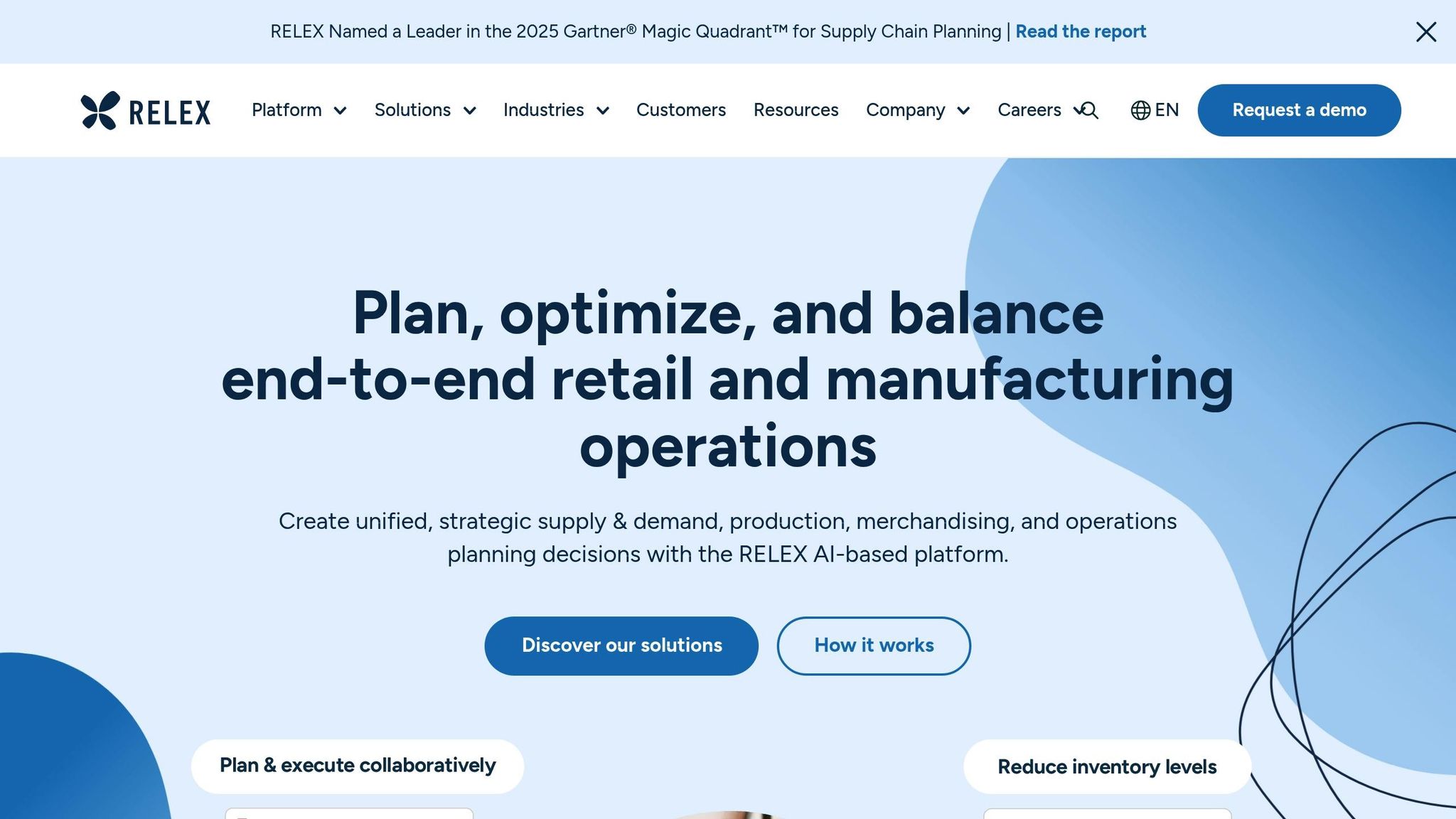
Relex Solutions offers an AI-driven platform tailored for seasonal demand forecasting, blending demand planning, merchandising, supply chain, and operations into one seamless system. By breaking down data silos, it provides a unified approach to refine forecasts and streamline retail operations.
Forecasting Granularity (SKU/Store/Day)
Accurate forecasting is a cornerstone for managing seasonal demand shifts. Relex Solutions delivers forecasts at the SKU, store, and daily levels, achieving impressive results: up to 99% forecast accuracy, an 85% reduction in stock-outs, and a 30% cut in inventory levels.
Take Plukon Food Group, for instance. Managing over 300 SKUs with seasonal demand patterns, the company utilized Relex's forecasting tools to significantly enhance accuracy.
Mark Didden, Demand Planner at Plukon, explains: "to anticipate and respond to these fluctuations, helping us maintain more stable production and service levels."
Tailored Solutions for Seasonal Trends
Relex's machine learning capabilities shine when it comes to complex seasonal trends. It doesn't just track basic seasonality - it incorporates factors like merchandising strategies, internal adjustments, external events, consumer behavior shifts, and even weather changes.
A standout example is WHSmith, which integrated airline data into Relex's system to align forecasts with flight schedules at airport locations. This approach reduced fresh spoilage rates, improved product availability, and enhanced overall forecasting accuracy.
The platform also supports retailers in modeling price elasticity, helping optimize markdown strategies during seasonal transitions. Using AI, it determines the best markdowns based on pricing dynamics and stock levels, offering flexibility to apply clearance strategies across regions, product categories, or specific stores.
Seamless Integration with Marketing and Inventory
Relex doesn't just stop at forecasting - it connects with existing systems to unify supply chain and retail operations. By breaking down communication barriers, the platform ensures all processes - from procurement to sales - are aligned.
"The greatest advantage the RELEX platform brings us is that we can easily adapt it for our needs. It doesn't force us to adapt our processes to the software like other systems do. Instead, we're adapting the system to our processes." – Jürgen Mattulke, Director of Supply Chain at Rossmann
Major retailers like Lowe's and Family Dollar have leveraged this integration, allowing their analysts to access comprehensive insights through a single, user-friendly platform.
Real-time Analytics and Dashboards
Relex Solutions also excels in real-time analytics, offering dashboards that track seasonal performance and enable quick responses to shifting demand. These tools allow businesses to monitor in-season trends and test alternative scenarios for better decision-making.
For example, Finsbury Food Group used these dashboards to improve their responsiveness. Similarly, Norgesmøllene enhanced forecasting accuracy and streamlined collaboration across their supply chain.
In seasonal planning, the platform has delivered exceptional outcomes. Coop Värmland, for instance, saw a 133% increase in inventory turnover, a 44% drop in spoilage, and a 75% reduction in clearance workload thanks to Relex's capabilities.
"RELEX seasonal planning solution has made the store process for assortment changes much more efficient and has maximized our profit when phasing out items." – Thomas Berglund, CIO, Coop Värmland
3. ThroughPut AI
ThroughPut AI stands out in the world of seasonal demand forecasting with its focus on delivering sub-day insights. By quickly transforming raw sales data into meaningful, actionable information, the platform helps businesses respond to demand fluctuations with impressive speed and precision.
Forecasting Granularity (SKU/Store/Day)
ThroughPut AI dives deep into demand patterns, offering sub-day visibility at the SKU and store levels using advanced algorithms. This level of detail empowers businesses to make localized inventory decisions during seasonal peaks, ensuring they stay ahead of shifting consumer needs.
The platform's AI-driven models are designed to adapt and learn, even when historical data is limited. These models can analyze trends across different items and stores, generating accurate forecasts tailored to specific regions, fulfillment centers, SKUs, and more. Businesses can also track key metrics like On-Time In-Full (OTIF) deliveries and identify missed opportunities. Retailers using ThroughPut AI have seen a 35% boost in in-stock availability and can respond to demand changes three times faster. Plus, the platform reduces forecasting errors by 30–40%, making it a reliable tool for demand planning.
Customization for Seasonal Trends
ThroughPut AI’s Demand Sensing Module goes beyond traditional forecasting by incorporating real-time external factors like economic shifts, geographic trends, and climate impacts. By combining these with historical data, the platform predicts how products will perform under varying conditions. It even leverages machine learning to analyze marketing events, helping businesses forecast how new products or services will respond to price changes and demand trends.
This feature is especially beneficial for retailers launching seasonal campaigns or introducing new products during busy periods. For example, during the coronavirus pandemic, a European retail giant used ThroughPut AI to save $20 million annually by optimizing fulfillment and shipping processes. The platform identified shipment bottlenecks and streamlined replenishment at the SKU level, cutting trucking costs by 10% and boosting revenue by 1% across over 100,000 SKUs.
"ThroughPut enables us to rapidly analyze an enormous amount of granular sales data, and generate a base sales forecast every week, going out a year and a half. There will always be adjustments to that forecast based on known variables not yet captured by the data, but to have a solid starting point at our fingertips at all times is a game changer for us." – Rick Russo, President Central California Cooling, former VP of Sales at Church Brothers
Integration with Marketing and Inventory Systems
ThroughPut AI’s Common Operating Platform connects data from across the physical value chain, breaking down silos and distributing corrective actions throughout the organization. By integrating everything from sales to manufacturing data, it provides a unified view of market fluctuations. And with ready-to-deploy integrations, businesses can be up and running in just days, not months.
This seamless integration has delivered measurable results: a 10% improvement in demand forecast accuracy, a 30% reduction in inventory, a 30% sales increase, and a 50% boost in delivery service levels. Companies have also reported a 65% reduction in bottlenecks, a 30% cut in lead times, and a doubling of inventory turns.
"ThroughPut's AI enabled speed of making existing data accessible from multiple siloed systems to derive useful information was breathtaking. This allows every company to minimize the barriers to implement AI at enterprise scale." – Jim Schulte, Former CIO
Real-time Analytics and Dashboards
ThroughPut AI’s real-time analytics are a game changer for businesses looking to manage seasonal demand. These tools detect shifts in demand patterns and provide actionable recommendations to adjust supply sources accordingly. The system processes data 600 times faster, enabling businesses to improve supplier and demand lead times.
"ThroughPut.AI's enhanced working capital management capabilities show our customers where their excess working capital lies, where their operations are underfunded, and projects how these gaps should best be optimized." – Seth Page, Chief Operations Officer and Head of Strategic Partnerships at ThroughPut.AI
Thanks to these capabilities, companies have reduced lead times by over 30% and increased production capacity by up to 20% in retail manufacturing operations.
sbb-itb-d4df0e6
4. LEAFIO AI Demand Planning
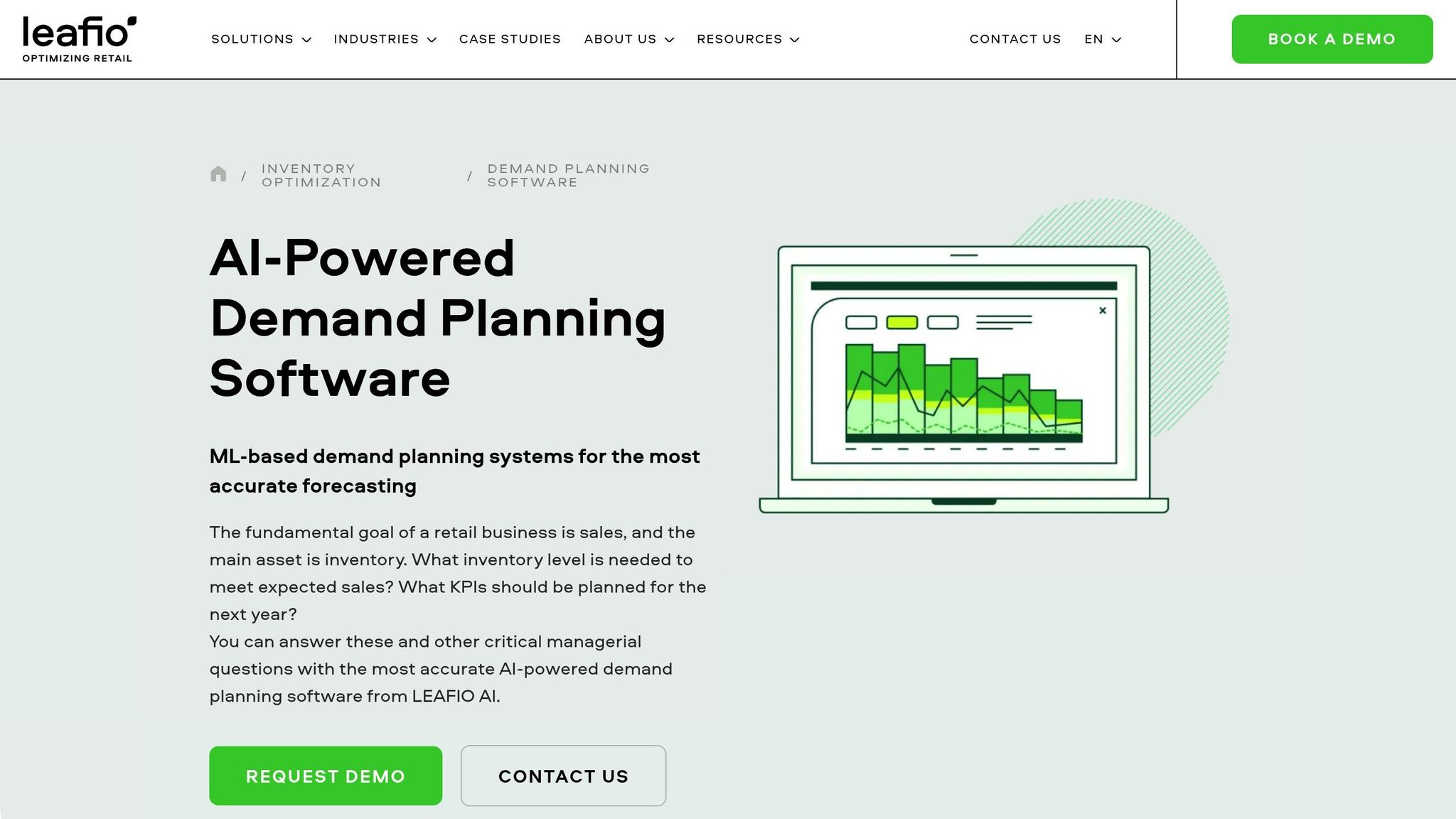
LEAFIO AI stands out as a demand planning tool that combines real-time data integration with detailed forecasting. What makes it unique is its ability to pinpoint seasonal spikes early, allowing businesses to fine-tune their inventory management. By analyzing sales history, promotional activity, and even weather patterns, LEAFIO AI creates a unified and highly accurate seasonal demand forecast.
Forecasting Granularity (SKU/Store/Day)
LEAFIO AI takes forecasting to the next level by focusing on individual items. Using advanced machine learning algorithms, it predicts demand for each SKU with impressive precision. The platform processes a wealth of data, including sales history, promotional trends, store traffic, and seasonality, while filtering out irrelevant noise for better accuracy.
What sets this tool apart is its ability to detect seasonal demand spikes early. This feature enables businesses to plan stock levels more effectively, avoiding the pitfalls of overstocking or running out of inventory during busy periods. Its granular approach allows retailers to make tailored decisions for each store, factoring in local performance and seasonal trends.
The results? LEAFIO AI improves forecast accuracy by 50%, reduces lost sales by 70%, and cuts overstock by 50%. These gains not only enhance cash flow but also boost customer satisfaction when it matters most - during peak seasons.
Customization for Seasonal Trends
When it comes to adapting to seasonal changes, LEAFIO AI offers unmatched flexibility. The platform automatically calculates and applies seasonality factors for both regular products with fluctuating demand and limited-time seasonal items. This dual capability ensures businesses can manage their core inventory while also planning for special events or holiday promotions.
Users can fine-tune forecasts by incorporating historical data, promotional impacts, and their own business insights. For larger retailers, LEAFIO AI supports bulk adjustments across multiple products, factoring in seasonal shifts, market changes, and promotional campaigns.
Its clustering model is especially useful for launching new products during seasonal periods. By analyzing sales data from similar items, the platform generates reliable forecasts for new inventory, helping businesses make smarter decisions about seasonal introductions.
"AI-driven inventory and assortment planning empowers retailers to meet fast-changing trends while minimizing the risk of overstock or financial loss." – Andrew Max, CCO of LEAFIO AI
Integration with Marketing and Inventory Systems
LEAFIO AI seamlessly integrates with POS, inventory, CRM, ERP, and supply chain systems, ensuring real-time updates for seasonal inventory management. Its connection to retail POS systems allows inventory levels to adjust instantly as sales occur, keeping demand planning accurate and up-to-date. Additionally, the platform works with barcode and RFID technology for streamlined stock tracking and verification.
Whether you're a small business or a large corporation, LEAFIO AI's flexible pricing model - based on the number of users, stores, and warehouses - makes it accessible to a wide range of businesses.
Real-time Analytics and Dashboards
LEAFIO AI doesn’t just predict demand; it helps businesses prepare for various scenarios. Its real-time dashboards provide scenario analysis based on current market conditions, offering insights into what might happen if demand surges or slows unexpectedly.
By processing diverse data sources, from macroeconomic trends to customer reviews, the platform gives retailers a comprehensive view of the factors shaping seasonal demand. LEAFIO AI standardizes this data for consistency and continuously updates its forecasting models with new information.
This dynamic approach gives businesses a competitive edge and helps maximize seasonal profitability. With its real-time capabilities, LEAFIO AI ensures companies can quickly adapt to shifting seasonal trends and market conditions, staying one step ahead.
5. Retalon Retail AI
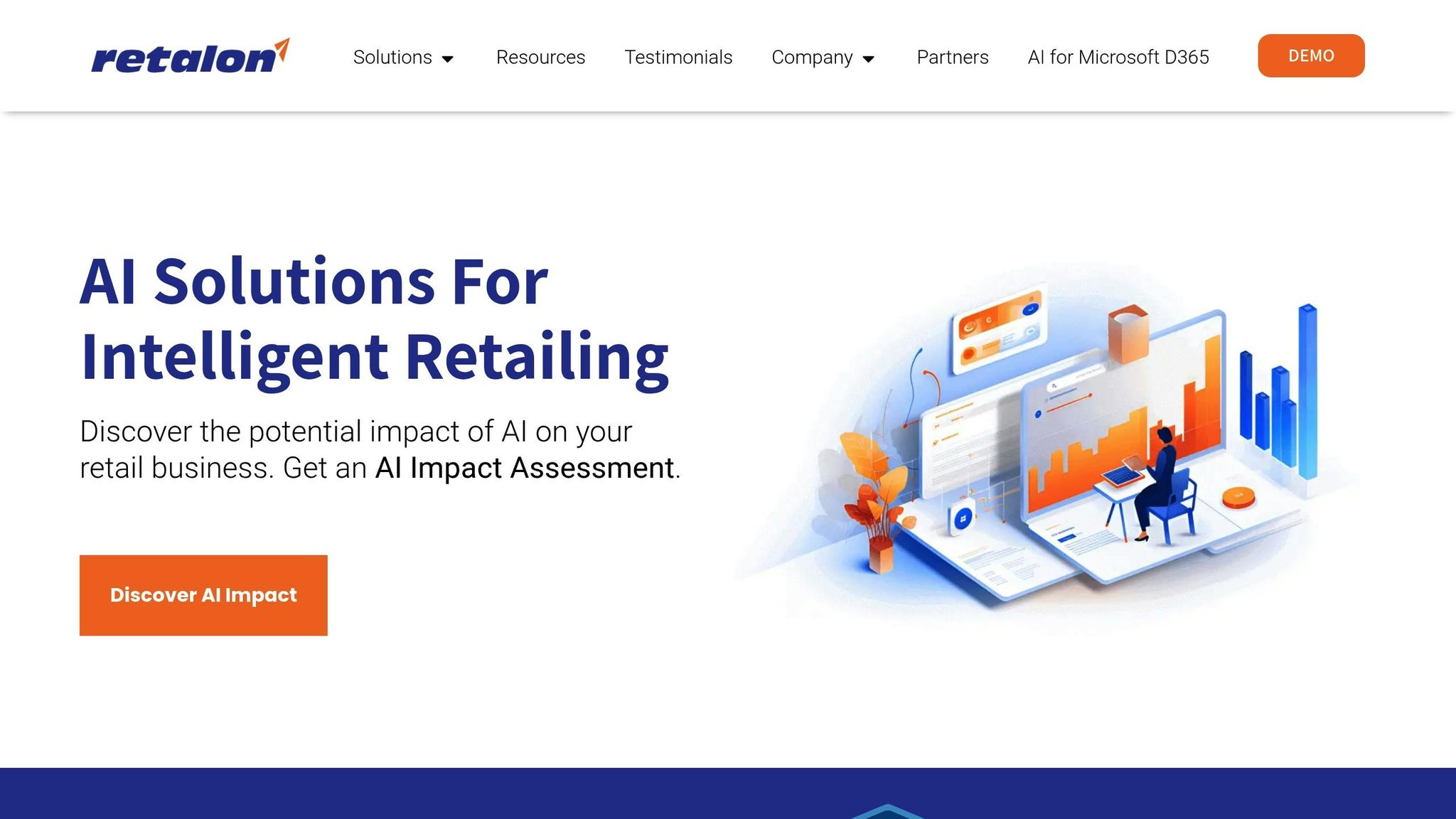
When it comes to seasonal demand forecasting, Retalon Retail AI stands out for its precision and enterprise-level capabilities. This platform provides detailed, AI-powered predictions that help retailers cut inventory levels by up to 30%. It analyzes data at a granular level - SKU, store, and daily trends - while considering factors like sales history, seasonality, price elasticity, and competition. These insights allow businesses to optimize inventory decisions and boost sales by 12–15%. Additionally, Retalon automates inventory allocation, factoring in business rules, capacity constraints, and promotional schedules.
Tom Shane, Executive Chairman of Shane Co., shared how Retalon revolutionized their merchandise rebalancing process:
"Prior to Retalon we were using a month-long rebalancing cycle to rebalance merchandise in our stores, with Retalon the process takes 15 minutes for the entire company."
Customization for Seasonal Trends
Retalon’s demand planning system is built to handle the complexities of seasonal trends. It incorporates dozens of variables, with seasonality being a key focus. By combining multiple forecasting methods, the platform delivers tailored demand predictions for any product at any location. It also integrates signals from various sales channels and fulfillment systems.
For instance, fashion retailer Simons leveraged Retalon to address challenges in aligning its boutique experience with inventory needs. The platform accurately predicted demand surges, adjusted shipment quantities, and fine-tuned promotional timing. This resulted in a 40% improvement in promotional forecast accuracy. Peter Simons, CEO of Simons, highlighted the platform's ability to interpret customer data effectively:
"In this era where the customers talk to you through that data, to be able to really hear not only when they're shouting things but also just whispering very quietly, Retalon helps us move through that data more gradually and make better decisions."
Integration with Marketing and Inventory Systems
One of Retalon's strengths lies in its seamless integration with existing systems, including custom ERP platforms and Microsoft Dynamics 365 Commerce. By unifying merchandise planning, inventory, orders, pricing, and promotions, the platform streamlines operations. Deployment is quick, taking less than six months, with a return on investment achieved in under three quarters.
Gary Craig, VP of Information Technology at La Maison Simons, shared how this integration has transformed their operations:
"In the past buyers managed inventory levels in stores. Retalon has automated this freeing buyers to focus on core operations."
Real-time Analytics and Dashboards
Retalon also offers powerful analytics tools that provide actionable insights for seasonal planning. By analyzing historical demand data, the platform refines future forecasts. Its predictive analytics identify products with high sales potential, optimize merchandise allocation, and adjust pricing and promotional strategies. These tools can lead to a 60% improvement in promotion efficiency, a 15% boost in gross margins, and a 50% reduction in inventory costs.
For seasonal retailers, these results mean better cash flow and fewer markdowns at the end of the season. Tom Anderson, CEO of The Paper Store, highlighted this advantage:
"Retalon makes sure we don't have excess inventory that we're going to have to write off at the end of a season or holiday."
Tool Comparison Chart
The chart below provides a clear comparison of the key features offered by each AI forecasting tool covered earlier.
| Feature | Experiment Driven | Relex Solutions | ThroughPut AI | LEAFIO AI Demand Planning | Retalon Retail AI |
|---|---|---|---|---|---|
| Forecasting Detail Level | Customer-level cohort analysis, channel-specific predictions | SKU, store, and daily granularity | Real-time inventory flow modeling | Product and location-specific | SKU, store, and daily trends |
| Seasonal Customization | A/B testing for seasonal campaigns, creative strategy optimization | Advanced seasonality algorithms with promotional impact | Real-time seasonal simulation | Seasonal coefficient settings | Dozens of seasonal variables integration |
| System Integration | Real-time dashboards, marketing channel integration | ERP, POS, and supply chain systems | Supply chain and logistics platforms | ERP and vendor management systems | Custom ERP, Microsoft Dynamics 365 |
| Real-time Reporting | Live performance dashboards, instant insights | Continuous monitoring and alerts | One-day resolution timeline updates | Management team collaboration tools | Automated inventory allocation updates |
| Primary Use Case | Marketing performance and customer acquisition | Retailers managing complex inventory | Supply chain and logistics | New product launches and substitutions | Enterprise retail operations |
| Deployment Time | Immediate setup for testing | 3–6 months typical | Varies by complexity | Quick implementation | Less than 6 months |
| Best For | Marketing teams focused on growth metrics | Large retailers with complex inventory | Supply chain-heavy operations | Companies with diverse product portfolios | Enterprise retail chains |
This breakdown highlights how each platform addresses seasonal demand in its own way.
Experiment Driven shines in marketing-focused seasonal forecasting. It’s a great choice for businesses looking to tie seasonal demand patterns directly to metrics like Cost Per New Customer or Cohort Payback Periods by marketing channels. This makes it particularly useful for optimizing customer acquisition during peak seasons.
For retailers, Relex Solutions and Retalon Retail AI lead the way with their advanced SKU-level data processing. Deciding between the two often depends on how well their integrations fit your existing systems and the specific needs of your retail operations.
ThroughPut AI sets itself apart with its discrete-event simulation, which creates highly detailed, one-day resolution timelines to model inventory flows. This is especially valuable for businesses with intricate supply chains that outgrow static forecasting methods.
If your business frequently launches new products or deals with substitutions, LEAFIO AI Demand Planning offers impressive adaptability. By linking new product profiles to historical sales data, it’s an excellent tool for managing dynamic product lines.
Each tool has unique strengths that can help minimize forecasting errors and improve seasonal performance. Choosing the right one for your needs can lead to measurable returns and better alignment with your operational goals.
Final Thoughts
AI-driven seasonal demand forecasting has transitioned from being a luxury to a must-have for businesses. According to McKinsey, integrating AI into forecasting can slash supply chain errors by 30–50% and reduce lost sales from stockouts by up to 65%. These enhancements not only improve inventory management but also trim operational costs, paving the way for more profitable decision-making.
The benefits are evident in real-world success stories. For instance, in 2025, Canadian fashion brand Kate Hewko boosted inventory efficiency by 40% using AI tools that accounted for seasonality, regional preferences, and style-specific trends. Similarly, Walmart leverages AI to process over 1.6 billion data points daily, cutting food waste by $86 million in a single year and improving forecasting accuracy by 20%.
Selecting the right tool is key. If your focus is on seasonal demand spikes or customer acquisition, platforms like Experiment Driven offer AI solutions tailored to optimize marketing efforts. On the other hand, businesses managing large inventories or complex supply chains might need tools with features that address those specific challenges. Matching the tool to your operational goals is crucial.
Start small with a pilot program to test improvements in areas like inventory control or customer acquisition. This step-by-step approach helps you evaluate accuracy, gather insights, and fine-tune strategies without risking your broader operations. Once validated, you can scale up and fully harness the advantages AI offers.
AI adoption doesn’t just streamline processes - it delivers measurable savings. Transportation and warehousing costs can drop by 5–10%, while supply chain administrative expenses may be reduced by 25–40%. More importantly, AI helps businesses seize revenue opportunities that traditional forecasting methods often miss.
FAQs
How do AI tools make seasonal demand forecasting more accurate than traditional methods?
AI tools have transformed the way businesses forecast seasonal demand by diving deep into massive, complex datasets with a level of accuracy that traditional methods simply can't match. Unlike older, static models, AI can handle numerous variables at once, adapt to changing market conditions, and continuously refine its predictions by learning from fresh data. The result? Sharper forecasts with fewer mistakes.
Using advanced algorithms, AI uncovers patterns that conventional models often overlook - especially when it comes to seasonal shifts. This ability allows businesses to stay ahead of demand changes, streamline their inventory management, and boost overall efficiency. In today's fast-paced market, AI has become an essential ally for marketers and decision-makers looking to stay competitive.
What should businesses look for in an AI tool to forecast seasonal demand effectively?
When choosing an AI tool for seasonal demand forecasting, it's important to zero in on a few key factors to ensure the insights it delivers are both precise and useful. Data quality stands at the top of the list - accurate predictions rely on a foundation of reliable, well-rounded data. The tool should also factor in historical patterns, external variables like holidays or weather shifts, and market trends that could impact demand.
It's also worth checking if the tool allows for customization to suit the specific needs of your industry. A system that integrates smoothly with your existing tools and delivers clear, actionable recommendations can play a major role in fine-tuning your seasonal planning.
How can AI tools for seasonal demand forecasting work with current marketing and inventory systems?
AI tools for seasonal demand forecasting can connect directly with your marketing and inventory systems using API connections or other integration techniques. These connections allow real-time data sharing, helping you make more accurate demand predictions. This, in turn, supports smarter marketing strategies and ensures inventory levels are adjusted to meet customer needs.
When AI models are incorporated into platforms like ERP or supply chain management systems, decision-making becomes sharper, operations run more smoothly, and businesses can respond faster to shifts in the market. This kind of integration helps prevent stockouts, cuts down on surplus inventory, and enables more targeted, data-driven marketing efforts - all contributing to steady and efficient growth.
